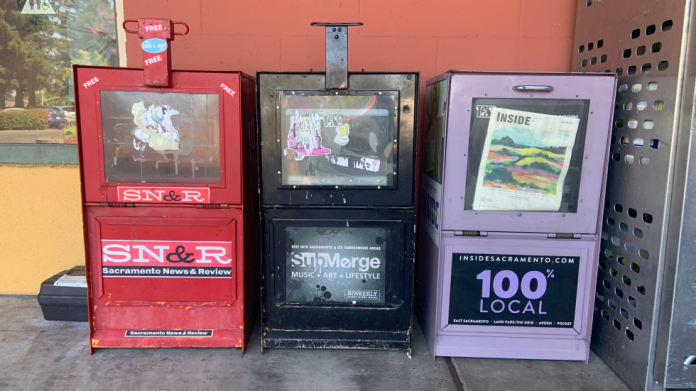Sacramento Magazine editorial director Krista Minard was
blindsided in July 2023. She was told the publication would close
four days before getting eye surgery. A few months later she was
in for another surprise. Emails from former colleagues led her to
discover the magazine’s website as she knew it was gone. SacMag.com was still online,
but in its place was something she calls “rudimentary.”
“It’s got a few stories up there, but no real rhyme or reason to
which ones were chosen to put up,” says Minard, who has
contributed to Comstock’s. The magazine had been published in
print since 1975, “but material that was online went back to
about 2006, and all that went away.” About two decades’ worth of
articles and photographs documenting the Capital Region’s history
disappeared from the internet. While the digital print replicas
from March 2020 to the present remained on the website, pretty
much everything else was taken offline. Now Minard encourages
reporters to back up their work while they still can.
“You never know what can happen, Minard says. “And boy, we sure
got that message loud and clear last summer.”
Unfortunately for journalists, digital permanence is a myth. Last
year more than two newspapers closed a week on average in the
United States, according to
a report from the
Medill School of Journalism at Northwestern University. When web
hosting bills go unpaid, online content disappears. A study from
the
Pew Research
Center published in May found that 38 percent of web
pages created in 2013 are no longer accessible. More than half of
Wikipedia pages contain at least one source leading to a dead
link.
A physical archive is left behind too when a newspaper or
magazine dies. Often this collection of back issues, sometimes
bound together in volumes, is donated to a library, museum or
government archive like the Center for Sacramento History.
That’s where Sacramento Magazine’s print collection went for
future preservation. Now to see them requires sifting through
boxes at the center’s warehouse, scheduled appointment only. (The
Sacramento Room at the central branch of the Sacramento Public
Library also has all issues of Sacramento Magazine from 1979 to
2023 available for viewing without an appointment.)
Marybeth Bizjak, Sacramento Magazine’s former dining editor and a
contributor to Comstock’s, says she was “incensed” by the website
shutdown. Bizjak, who wrote for the publication for decades,
thought it would likely close eventually, but says “It didn’t
occur to me that the internet archives would ever go away, and
that just shocked me. I was so surprised.”
After the Michigan-based Hour Media shut down its
subsidiary Sacramento Media, which published Sacramento Magazine,
some of the remaining assets including intellectual property like
subscriber and advertising lists were sold to the owners of
Sactown Magazine. The
terms of the sale were not publicly disclosed, and Hour Media did
not respond to requests for comment. Reached by email, Sactown’s
co-owner Rob Turner wrote that the sale included web domain
names, but not the website itself.
Sacramento Magazine’s website was taken down, and Turner paid for
a new website to be built from scratch as a placeholder with a
handful of articles. This is how SacMag.com appears today. The amount of
time, effort and money it would take to upload thousands of
articles along with possible legal concerns over copyright and
libel is why Turner said he never had the website fully restored.
However, Sacramento Magazine’s digital editions uploaded to
Issuu and
BlueToad are still
accessible. Combined, more than a hundred issues are on the two
publishing platforms, although it can be difficult to find
content on these platforms through search engines like
Google.
“From what I’ve witnessed and experienced first-hand, most online
stories don’t live on forever,” Turner writes. “In Sacramento
Magazine’s case, however, nearly 13 years of full issues online
is more than I’ve seen for most other magazines.”
When media outlets close
Sacramento Magazine lives on in a
diminished form online. But there are news websites that
don’t exist beyond the life of the business. Originating in the
summer of 2014, City Scout Magazine was an Instagram passion
project turned blog with aspirations of becoming a quarterly
print publication. About 10 writers and photographers, mostly
volunteers, contributed food and travel guides to the website. It
was never profitable, owners Felix and Nicolette Molina told me.
City Scout’s last article was posted in October 2019.
An abandoned Sacramento Bee newspaper vending box. (Photo by Eric
Schucht)
By then the couple had new priorities and
didn’t have the time or money to run City Scout as a hobby. The
website and social media accounts sat dormant for years until the
owners deleted them after an offer to sell the assets fell
through. All articles have vanished from search engines. The web
domain rights expired and were purchased by another party.
Felix says “It felt best to close all doors and just let it be.”
The couple wanted to move on and felt the website didn’t have any
long-term value. Most of the businesses City Scout wrote about
have closed. The guides they published weren’t usable anymore.
The owners thought other outlets covered the same topics and
didn’t see value in keeping their articles up or preserving them.
“It never crossed my mind,” says Nicolette, who has contributed
photography to Comstock’s. “The business stopped existing. It’s
like a brick-and-mortar. If the business sells, it closes down
and something else moves in. And I guess it felt more like that.
It’s like, okay, pack it up and move on.”
While CityScoutMag.com was
taken down following the publication’s closure, some websites of
defunct Sacramento-area publications are intact (at least for
now). Alt-weekly Submerge Magazine’s website
remains up despite its closing four years ago. The owners Melissa
Welliver and Jonathan Carabba said through Facebook Messenger it
only costs them a few hundred dollars a year to keep the site up.
Submerge’s website will remain in status quo until a long-term
plan is devised. Maybe one day the magazine will relaunch as the
couple’s hobby.
For now, SubmergeMag.com
lives because, the owners write, “There’s a lot of great content
that might want to be viewed again by friends, family or fans of
the people we featured in the decade-plus Submerge was a part of
documenting Sacramento art and entertainment.”
Tim Foster felt the same way about Midtown Monthly,which ran for
six years until closing in 2012. Foster owned the publication for
a time and reacquired its assets when it ceased. He said
Midtown’s website was an afterthought, and most print content was
never uploaded. However, he feels those online articles still
have value.
“We covered things that other people weren’t looking at, and I
wanted to keep that out there,” Foster says. However, the site is
in a “diminished state” due to outdated software. Images and text
formatting are missing. Hyperlinks don’t work without editing the
URL. One day Foster wants to hire a web designer to fix up
MidtownMonthly.net.
Aging technology is what makes maintaining online articles a
challenge.
What happens to digital news?
Preserving paper is pretty straightforward. Preserving digital
media is more complicated, says Marcia Eymann, city historian at
the Center for Sacramento History. Technology changes and storage
formats come and go. Film has been around for hundreds of years,
but does anyone still remember LaserDisc? It takes effort to
transition files from one system to the next. When done,
questions can arise over how long those devices will function
over millennia.
“I know how long a piece of paper will last. I can give you an
idea of how long a photograph will last,” Eymann says. But as for
digital files, she has “no idea how long that’s going to exist.”
A collection of bound Sacramento Bee newspapers stored at the
Center for Sacramento History. (Photo by Eric Schucht)
Eymann says the center does not preserve websites at this time.
They’ll scan photographs and newspapers for accessibility, but
the entirety of Sacramento Magazine’s original website isn’t
something the center has the resources to keep online. So how
will the Capital Region preserve its past amid the decline of
print news media?
Some articles are only ever published online. Sacramento News & Review and
Capitol Weekly ceased
publishing in print, and news outlets launched in recent years
like Stocktonia and the
Folsom Times are
digital only. How can their articles be saved for the
future?
The Internet Archive’s Wayback Machine is one
solution. The nonprofit’s software crawls the publicly accessible
internet to download webpages. It isn’t perfect,
according to
Lakehead University in Ontario, Canada. The automated
program sifts through the internet backing up websites. Sometimes
pages weren’t downloaded before the article was yanked offline.
Sometimes pages are saved but displayed incorrectly. Images or
text formatting could be missing. Embedded video and audio files
might not play. Plus, finding web pages requires a tedious search
without the URL in hand.
The
Library of Congress also archives web content. In
California, there’s an effort underway to preserve the state’s
newspapers at the UC Riverside’s Center for Bibliographical
Studies and Research. Director Brian Geiger said the center
functions as the Golden State’s newspaper repository and
digitizes millions of pages as part of the California Digital Newspaper
Collection. The center doesn’t archive websites or
accept magazines at this time. There are plenty of print
newspapers on hand to keep them busy, but things are changing.
For decades, local libraries and historical societies have
collected newspapers to be microfilmed. Geiger said that work
largely ended in the 2010s.
“We’ve got this gap now of ten or more years where papers just
aren’t being saved,” Geiger says. “There’s no concerted effort to
save them, so it’s kind of catch as catch can.” The center
adapted and has a small project called “Born Digital” where
publishers send PDFs of newspapers for preservation. It isn’t
popular.
“It’s a real question whether this period of newspapers is going
to be available to researchers decades from now,” Geiger says. “I
suspect it’s not.”
People have to be proactive about preserving media before it’s
gone, Geiger said. However, he doesn’t necessarily believe
publishers want to be nor should be responsible for the long-term
preservation of their content. He thinks public institutions need
to start planning for a world where more and more content is only
ever online.
“We’ve got now over decades worth of digital content that hasn’t
been preserved in any way, and if we don’t do something soon,
we’re going to lose it.”
Correction September 19, 2024: A previous version of this
article stated that back issues of Sacramento Magazine are only
available by appointment at the Center for Sacramento History.
They are also available without an appointment at the central
branch of the Sacramento Public Library.
–
Subscribe to the
Comstock’s newsletter today.







